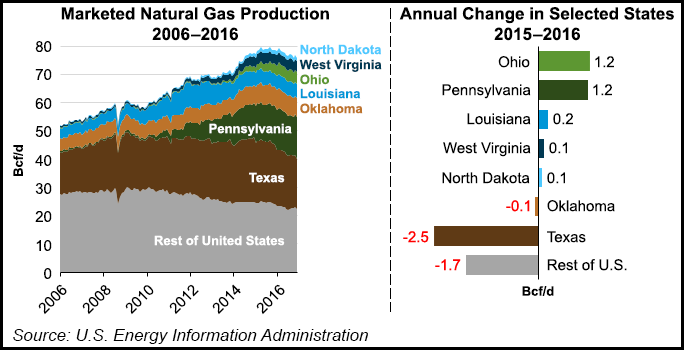E&P | NGI All News Access | NGI The Weekly Gas Market Report
U.S. Marketed NatGas Production Declined 2.5% in 2016, EIA Says
Marketed natural gas production increased from two shale-heavy states in 2016, but that was overshadowed by a 2.5 Bcf/d decline in Texas, resulting in an overall national decline compared with 2015, the first annual decline in more than a decade, according to the Energy Information Administration (EIA).

“After reaching a record high of 79 Bcf/d in 2015, U.S. marketed natural gas production fell to 77 Bcf/d in 2016, the first annual decline since 2005,” EIA said. “Texas, the state with the most natural gas production, fell by 2.5 Bcf/d, while Ohio and Pennsylvania each increased by about 1.2 Bcf/d.”
Pennsylvania and Ohio had the two largest annual production increases compared to 2015, reflecting higher production from the Utica and Marcellus shale plays, which have accounted for 85% of the U.S. shale gas production growth since 2012. “Production in Pennsylvania and Ohio has accounted for an increasing share of total U.S. natural gas production in recent years, growing from less than 2% in 2006 to 24% in 2016,” EIA said.
Pennsylvania surpassed Louisiana in 2013 to become the second-highest natural gas producing state, behind Texas. Although both states had higher production in 2016, Ohio surpassed West Virginia last year to become the seventh-highest natural gas-producing state.
“Theincreased productivity of natural gas wells in the Marcellus Shale and Utica Shale is a result of ongoing improvements in precision and efficiency of horizontal drilling and hydraulic fracturing occurring in these regions,” EIA said.
Louisiana, West Virginia and North Dakota also increased their natural gas production in 2016.
EIA measures natural gas production in three ways:
In its most recent Short-Term Energy Outlook (STEO), EIA said it expects natural gas production to increase in both 2017 and 2018 as natural gas prices rise, resulting in higher rig activity. Henry Hub prices are expected to increase to an annual average of $3.10/MMBtu in 2017 and $3.45/MMBtu in 2018. EIA’s estimated 2017 average Henry Hub spot price, which had tumbled 12% in the agency’s March STEO, took an upturn in the April report, rising to $3.10/MMBtu, a 2.2% increase compared with the previous forecast.
The 2018 Henry Hub spot price is expected to average $3.45/MMBtu. The price increases reflect the expectation of increased natural gas consumption, increased exports, and lower average inventory levels, EIA said.
© 2024 Natural Gas Intelligence. All rights reserved.
ISSN © 1532-1231 | ISSN © 2577-9877 | ISSN © 1532-1266 |
